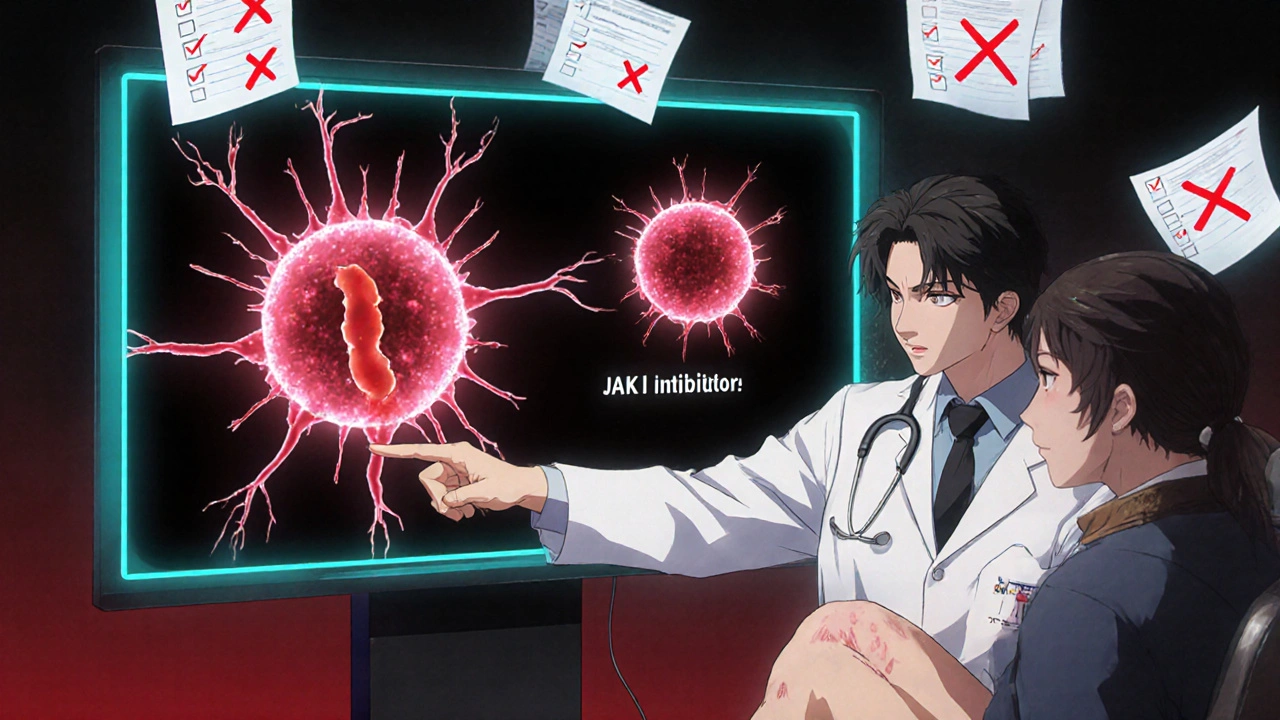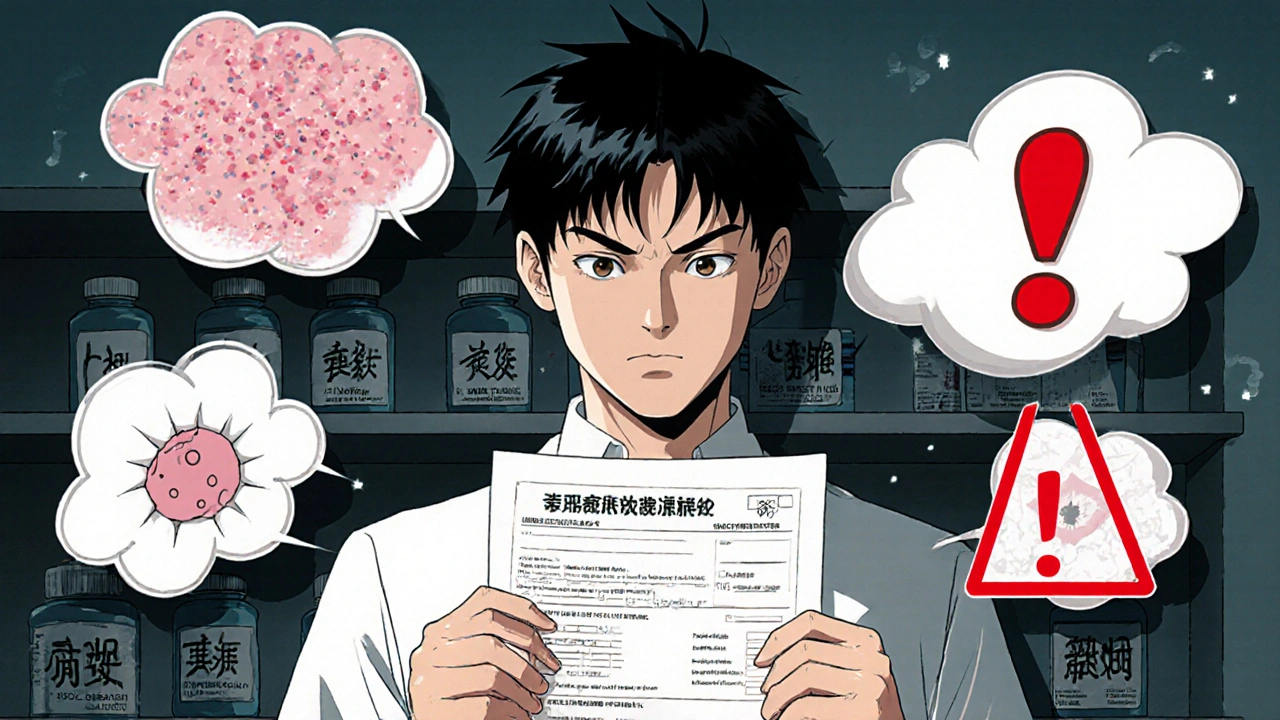JAK Inhibitor Risk Calculator
Personal Risk Assessment
This tool helps you understand your individual risk for infections and blood clots when taking JAK inhibitors. Based on your medical profile and lifestyle factors, it will provide personalized risk assessment and monitoring recommendations.
Your Profile
When you start a JAK inhibitor for rheumatoid arthritis, psoriatic arthritis, or another autoimmune condition, you’re choosing a drug that works fast. It blocks specific signals in your immune system that cause inflammation. But that same power comes with serious risks you can’t ignore: infections and blood clots. These aren’t rare side effects. They’re well-documented, life-threatening complications that require active monitoring - not just a one-time conversation with your doctor.
Why JAK Inhibitors Increase Infection Risk
JAK inhibitors don’t just calm down the overactive immune cells attacking your joints. They also dull your body’s ability to fight off real threats like viruses, bacteria, and fungi. This isn’t theoretical. Data from the ORAL Surveillance trial, which followed over 4,300 rheumatoid arthritis patients for up to four years, showed that people on tofacitinib had a significantly higher rate of serious infections than those on TNF inhibitors. The most common? Herpes zoster - also known as shingles. Even if you got the shingles vaccine before starting treatment, it doesn’t guarantee protection. One patient on Reddit shared that she developed shingles just three months after starting tofacitinib, despite being vaccinated. She ended up hospitalized for five days. That’s not an outlier. Studies show herpes zoster accounts for over 14% of all infection reports linked to JAK inhibitors. Other serious infections include tuberculosis, pneumonia, and invasive fungal infections like candidiasis or aspergillosis. The problem isn’t just the drug itself - it’s timing. If you start a JAK inhibitor while you’re carrying a hidden infection, it can explode. That’s why guidelines now demand you get all necessary vaccines - including pneumococcal, influenza, and hepatitis B - at least four weeks before beginning treatment. Live vaccines like MMR or varicella are absolutely off-limits once you’re on the drug. And if you develop a fever, cough, or unexplained skin rash while taking a JAK inhibitor, don’t wait. Call your doctor immediately. These drugs can turn a mild illness into something dangerous in days.Thrombosis: The Silent Threat
While infections are more common, blood clots are more deadly. Venous thromboembolism (VTE), which includes deep vein thrombosis (DVT) and pulmonary embolism (PE), is now a black box warning for all JAK inhibitors. That’s the FDA’s strongest alert - reserved for drugs that can cause death or serious harm. The risk isn’t the same for everyone. Patients over 65, current or former smokers, those with a history of blood clots, or people with obesity (BMI ≥30) are at highest risk. One study found that patients with prior VTE had more than five times the risk of another clot on JAK inhibitors. A 62-year-old woman on upadacitinib for psoriatic arthritis developed a DVT in her calf after a long flight. Her rheumatologist stopped the drug immediately. She didn’t need surgery, but she spent months on blood thinners. Why does this happen? JAK2 inhibition interferes with platelet production and blood vessel function. It doesn’t make your blood thicker - it disrupts the natural balance that keeps clotting in check. The data is clear: JAK inhibitors increase the odds of a pulmonary embolism by nearly three times compared to other treatments. A 2022 analysis of over 126,000 patients showed a 2.37-fold increase in overall thromboembolic events. For some, it’s a single event. For others, it’s a recurring nightmare.Not All JAK Inhibitors Are the Same
You might think all JAK inhibitors are equal. They’re not. There are key differences in how they work - and how dangerous they can be. Tofacitinib (Xeljanz) is a pan-JAK inhibitor. It blocks JAK1, JAK2, and JAK3. That’s why it’s linked to the highest rates of blood clots and heart events. The ORAL Surveillance trial showed it had a 73% higher risk of pulmonary embolism compared to TNF inhibitors. Upadacitinib (Rinvoq) and baricitinib (Olumiant) are more selective. Upadacitinib mainly targets JAK1, which is why newer data suggests a lower VTE rate - 0.2 events per 100 patient-years in low-risk patients, compared to 0.9 for tofacitinib. Filgotinib, approved in Europe, shows even less JAK2 inhibition, which may mean less clotting risk. But here’s the catch: these differences are still being studied. No JAK inhibitor is “safe.” The FDA and EMA have issued black box warnings for all of them. The bottom line: your doctor shouldn’t just pick the most popular one. They need to match the drug to your risk profile. If you’re over 65 with high blood pressure and a history of clots, upadacitinib might be a better choice than tofacitinib - but only if there are no other options.
What You Need to Monitor - Monthly Checklists
If you’re on a JAK inhibitor, your care doesn’t stop at the prescription. You need a routine. Here’s what you must track:- Every 4-8 weeks: Complete blood count (CBC). Low white blood cells or platelets can signal trouble before symptoms show.
- At 4 and 12 weeks: Lipid panel. JAK inhibitors raise cholesterol - total, LDL, and HDL. You may need a statin.
- Before starting: Baseline D-dimer and lower limb ultrasound if you’re high-risk for clots. This isn’t routine everywhere, but it should be for smokers, older adults, or those with prior clots.
- Every visit: Ask yourself: Any new swelling, redness, or pain in a leg? Shortness of breath? Fever? Cough? Unusual fatigue? Don’t wait for your next appointment - call your doctor if any of these appear.
When to Stop the Drug
You don’t need to panic over every cold. But some signs mean you must stop immediately:- Confirmed deep vein thrombosis or pulmonary embolism - stop the drug and start anticoagulants.
- Active serious infection (like pneumonia, sepsis, or tuberculosis) - hold the medication until fully treated.
- Unexplained fever lasting more than 48 hours - don’t assume it’s a virus.
- New skin lesions, especially blisters or ulcers - could be herpes or fungal infection.
Who Should Avoid JAK Inhibitors Altogether?
Not everyone should even try these drugs. The EMA and FDA agree on these absolute red flags:- Age 65 or older with cardiovascular risk factors
- Current or former smoker with heart disease or high blood pressure
- History of blood clots, stroke, or heart attack
- History of cancer (except successfully treated non-melanoma skin cancer)
- Active infection or untreated hepatitis B or C

The Real Cost of Monitoring
There’s a hidden price tag to these drugs. Between blood tests, specialist visits, and imaging, monitoring costs about $385 per patient per year. Many practices now use digital checklists to track risk factors before prescribing. Over 78% of U.S. rheumatology clinics use them now - up from just 32% in 2020. That’s progress. But it’s not enough. You need to be your own advocate. Keep a log of symptoms. Know your numbers. Ask your doctor: “Is this drug still right for me?”What’s Next?
Newer drugs are coming. TYK2 inhibitors, like deucravacitinib, are showing promise with fewer clotting risks. But they’re not yet approved for rheumatoid arthritis. For now, JAK inhibitors are here to stay - but their role is shrinking. In 2020, they made up 35% of new biologic prescriptions for rheumatoid arthritis. By mid-2023, that dropped to 28%. TNF inhibitors are back in favor because they’re safer, even if they take longer to work. The message is simple: JAK inhibitors work. But they’re not for everyone. If you’re considering one, demand a full risk assessment. Don’t accept a one-size-fits-all answer. Your life depends on the details.Can JAK inhibitors cause shingles even after vaccination?
Yes. Even if you received the shingles vaccine (Shingrix) before starting a JAK inhibitor, the drug can still suppress your immune response enough to allow the virus to reactivate. Studies show herpes zoster accounts for over 14% of all infection reports with these drugs. The vaccine reduces risk but doesn’t eliminate it. If you develop a painful, blistering rash after starting treatment, seek medical care immediately.
Which JAK inhibitor has the lowest risk of blood clots?
Current data suggests upadacitinib (Rinvoq) and filgotinib have lower rates of venous thromboembolism compared to tofacitinib (Xeljanz), especially in patients without prior clotting history. Upadacitinib’s JAK1-selective profile may spare JAK2 pathways that drive clotting. However, no JAK inhibitor is risk-free. The FDA and EMA have issued black box warnings for all of them. The choice depends on your individual risk factors - not just which drug is "safer."
How often should I get blood tests while on a JAK inhibitor?
You should get a complete blood count (CBC) every 4 to 8 weeks to check for low white blood cells, red blood cells, or platelets. A lipid panel should be done at 4 and 12 weeks after starting, since these drugs raise cholesterol levels. If you’re over 65 or have heart disease, your doctor may also monitor liver enzymes and kidney function more frequently. Never skip these tests - they catch problems before you feel symptoms.
Can I take JAK inhibitors if I’ve had a blood clot before?
Generally, no. If you’ve had a deep vein thrombosis or pulmonary embolism in the past, JAK inhibitors are strongly discouraged. Studies show these patients have more than five times the risk of another clot on these drugs. Guidelines from the FDA and EMA recommend avoiding JAK inhibitors entirely in people with a history of venous thromboembolism. Alternative treatments like TNF inhibitors or IL-17 blockers are safer options.
Do JAK inhibitors increase the risk of cancer?
Yes. The ORAL Surveillance trial found a 54% higher risk of malignancies (excluding non-melanoma skin cancer) in patients taking tofacitinib compared to TNF inhibitors. This includes lymphoma and lung cancer. The risk appears higher in older patients and smokers. While the absolute increase is small - about 1.5% over four years - it’s enough to warrant caution. If you have a personal or family history of cancer, discuss alternatives with your doctor before starting treatment.







